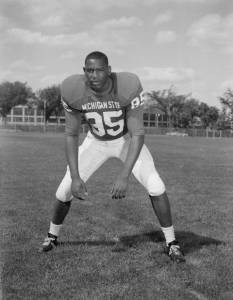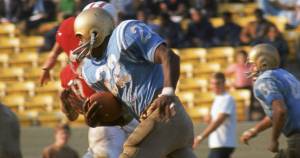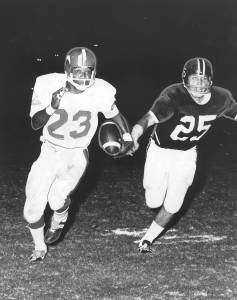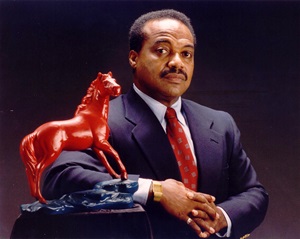Magnolia Park is just a few miles north of downtown Beaumont, Texas. That is where, in the early 1960s, high school football players gathered to practice and play informal games. Recreation for black kids then was minimal, so they created their own. Before boisterous crowds of 300 or more, these young men played a rough form of two-hand touch football. “We were all aiming for one thing—to make it to professional football, get a scholarship and go from that,” said one of them, Charles “Bubba” Smith. “We all went to the park every day, and you worked on your stuff. If you could do it, you could do it. We were always striving to do better…. It was a unique situation with a lot of guys who wanted to make it to the top.”
Some already had. George Reed, although not a Beaumont native, had married Angelina LeVias (whose younger brother Jerry was one of those athletes at Magnolia Park), and was a star running back at Washington State and then for 13 seasons in the Canadian Football League. Miller Farr (whose younger brother Mel also spent many hours honing his skills at Magnolia Park) was then playing defensive back at Wichita State; he went on to have nine strong seasons with the Denver Broncos, San Diego Chargers, Houston Oilers and St. Louis Cardinals. Although it’s not pertinent to our story, LeVias and the Farrs were cousins.

In the waning days of segregation, Beaumont had two black high schools: Charlton-Pollard (coached by Smith’s father, Willie Ray) and Hebert (coached by Clifton Ozen). Smith, a defensive lineman, and Farr, a running back, both graduated in 1963 and earned scholarships to Michigan State and UCLA, respectively. LeVias, a wide receiver, was two years behind. He signed with SMU in May 1965 and made history as the first black player in the Southwest Conference.
I propose to look at what these talented and dedicated young men did in the 1966 college football season, starting with Smith. At 6′ 7″ and 265 pounds, he would be considered big even today. Then, he was huge—and a terror to offensive linemen. Coach Duffy Daugherty had brought Smith to East Lansing along with several other talented black players from Texas, South Carolina, North Carolina and Virginia. They had a lot to do with the Spartans being ranked No. 1 or No. 2 the entire season. Smith was in the middle of the “game of the century” (odd, since Texas and Arkansas played in another such game in 1969, and Oklahoma and Nebraska in yet another in 1971) against Notre Dame. Fiercely contested, it ended with Irish coach Ara Parseghian letting the final seconds expire in a 10-10 tie. Farr and LeVias must have read about it in the next day’s newspapers because the Bruins were hosting Southern Cal at LA Memorial Coliseum and the Mustangs were hosting Baylor at the Cotton Bowl.
Smith was a consensus All-American in 1966, and so was Farr. Tommy Prothro’s UCLA team (which might have included LeVias, as they recruited him hard in ’65) was the best on the West Coast that year. They had been ranked as high as No. 2 and won every game except one—a 16-3 upset by Washington. The Bruins’ biggest challenge otherwise was against Rice in Houston. A field goal with seven seconds left gave them a 27-24 victory over the Owls. Farr gained 809 yards and scored 11 touchdowns that year, but his QB, Gary Beban, got even more attention and won the Heisman Trophy.
The 1967 Rose Bowl should have featured Michigan State of the Big 10 and UCLA of the Pacific Coast Conference. But due to convoluted rules and some strange behind-the-scenes politicking, those teams stayed home on New Year’s Day. Instead, Purdue and USC put on a desultory show. Farr and Smith, having no football to play, may have been in Dallas where LeVias and the SMU Ponies were meeting (and losing, 24-9, to) Georgia in the Cotton Bowl.
 Farr and Smith undoubtedly knew what their old Magnolia Park buddy had done for Hayden Fry’s team. Although the red and blue had other talented players (defensive lineman John LaGrone was an All-American, and several others made all-SWC), LeVias was the man—catching passes, returning punts and kickoffs, doing end-arounds and throwing halfback passes. He demonstrated with crystal clarity that the days of Jim Crow football were over. SMU went 8-2 in the regular season, won its first conference title since 1948 and was No. 10 before losing to the Bulldogs in the Cotton Bowl, in which LeVias caught a negligible three passes. He would play two more seasons of college ball and be named a consensus A-A in 1968.
Farr and Smith undoubtedly knew what their old Magnolia Park buddy had done for Hayden Fry’s team. Although the red and blue had other talented players (defensive lineman John LaGrone was an All-American, and several others made all-SWC), LeVias was the man—catching passes, returning punts and kickoffs, doing end-arounds and throwing halfback passes. He demonstrated with crystal clarity that the days of Jim Crow football were over. SMU went 8-2 in the regular season, won its first conference title since 1948 and was No. 10 before losing to the Bulldogs in the Cotton Bowl, in which LeVias caught a negligible three passes. He would play two more seasons of college ball and be named a consensus A-A in 1968.
While my focus here is the showing of Smith, Farr and LeVias as collegians in 1966, I must summarize their pro careers. Smith, top pick of the NFL draft in 1967 by the Baltimore Colts, took part in Super Bowls 3 and 4, playing later with the Oakland Raiders and Houston Oilers; he was a first-team All-Pro in 1971. Farr, a first-round pick by the Detroit Lions, was 1967 NFL rookie of the year, gained 3,072 yards from scrimmage and scored 36 touchdowns in seven seasons. LeVias, the AFL rookie of the year with the Oilers in 1969 (he also played for the Chargers), caught 144 passes, scored 14 touchdowns and had 5,200 yards on punt and kickoff returns. Smith, who went on to quite a career as a TV and movie actor, died in 2011. Farr, a successful Ford dealer in the Detroit area before it all came crashing down, died four years later. LeVias, who worked for several companies and then went into business for himself, is still alive and in good health at age 72.


7 Comments
Richard:
Very well done – I am a Notre Dame alum and Bubba Smith was always one of my favorite players – except during the ND-Michigan State game of 1966. Your details and photos of both the Farr brothers and Jerry LeVias are terrific!
Rex
Rex, you may note that I made no reference to what MSU fans cheered in those days: “Kill, Bubba, Kill!” I never liked this. It made him sound like a goon, and he was not. Smith was a pretty gentle guy off the field.
Your history of great football stories from the state of Texas seems in-exhaustible. I always enjoy the history and your particular sense of humor with some of the details (“game of the century”).
Thanks, Coach. Ohio State-Notre Dame in 1935, Notre Dame-Army in 1945, USC-UCLA in 1967, Miami-Penn State in 1986, Florida State-Notre Dame in 1993 and others have also been called “games of the century.” You were on the sideline during some momentous contests too, were you not?
Very cool article, I always wonder how the world turned out the way it did, and you seem to have a lot of the answers!
Thanks, big fella!
There is another player missing from this bunch. Clarence “Clancy” Williams born in Dewyeville, TX. But raised in Renton, Wa. He was the cousin of both the Farr’s and Levias’. Played his college ball WSU and then the LA Rams.
Add Comment